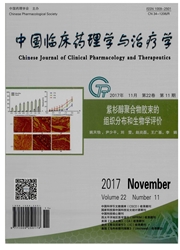

 中文摘要:
中文摘要:
目的:建立一种有效模拟临床颅内动脉瘤破裂后蛛网膜下腔出血病理生理过程的大鼠SAH模型。方法:显微操作经颈外动脉导入尼龙线至颈内动脉颅内段,刺破其分叉处造成大鼠SAH,观察各实验组大鼠死亡率、神经行为功能、脑含水量、大体病理解剖及海马区病理变化。结果:SAH模型成功率96.7%,死亡率10.34%;实验大鼠蛛网膜下腔发现血液或血凝块凝集;SAH后神经行为异常,24h神经功能评分为3.08±0.56分;脑含水量增加,皮层含水量为80.37±0.58%,脑干含水量为74.14±1.07%;海马CA1区神经元有水肿变性等改变。结论:非开颅血管内线穿刺法能可靠制备大鼠SAH模型并有效模拟临床颅内动脉瘤破裂出血后的蛛网膜下腔出血的病理生理过程。
 英文摘要:
英文摘要:
Objective:To establish a subarachnoid hemorrhage (SAH)model with simulated pathophysiologieal processes of clinic intracranial aneurysm rupture in rats. Methods:SAH was produced by passing a nylon thread through the right external carotid artery to internal carotid artery and piercing its furcation. Dynamic monitor of electroencephalogram and regional cerebral blood flow, the mortality and neurological deficits, brain water content, pathologic change were observed at 24h. Results:The achievement ratio of SAH model is 96. 7%, mortality 10. 34%. Neurological deficits was observed after SAH, mean neurological score 3.08 ± 0. 56. Brain water content increase and CA1 regions of hippocampus have hydropic degeneration at 24h after SAH. Conclusion:The noncraniotomy model of SAH in rats is reliable. It could effectively simulate clinic intracranial aneurysm rupture pathophysiological processes.
 同期刊论文项目
同期刊论文项目
 同项目期刊论文
同项目期刊论文
 The effect of ecdysterone on cerebral vasospasm following experimental subarachnoid hemorrhage in vi
The effect of ecdysterone on cerebral vasospasm following experimental subarachnoid hemorrhage in vi The effect of oxyhemoglobin on the proliferation and migration of cultured vascular advential fibrob
The effect of oxyhemoglobin on the proliferation and migration of cultured vascular advential fibrob The effect of oxyhemoglobin on the proliferation and migration of cultured vascular smooth muscle ce
The effect of oxyhemoglobin on the proliferation and migration of cultured vascular smooth muscle ce 期刊信息
期刊信息
